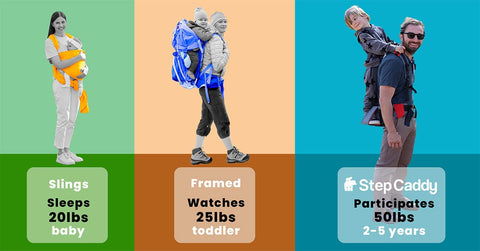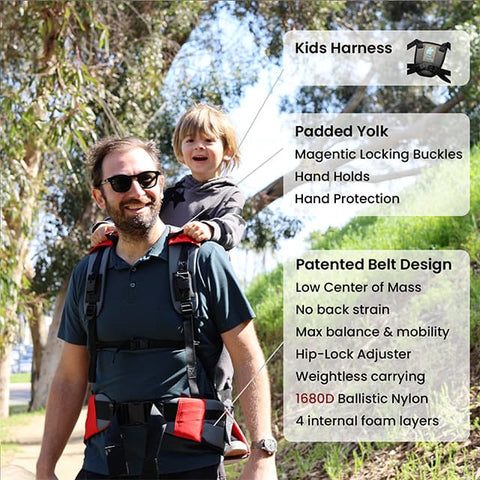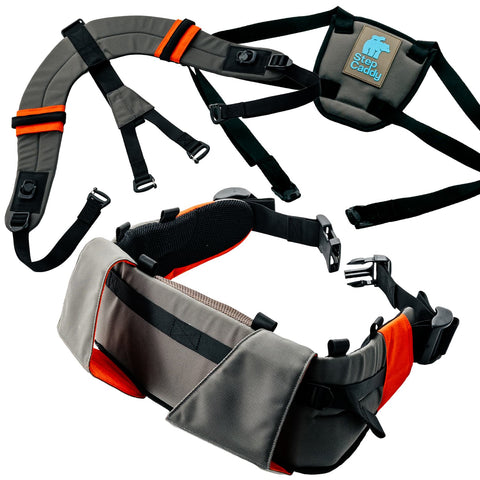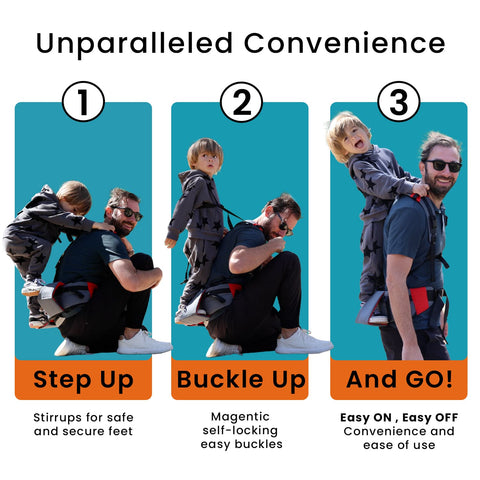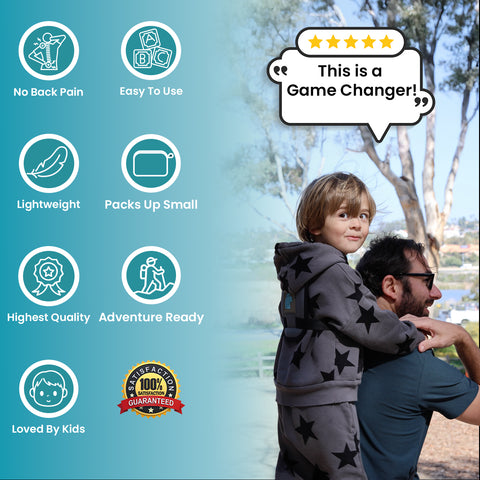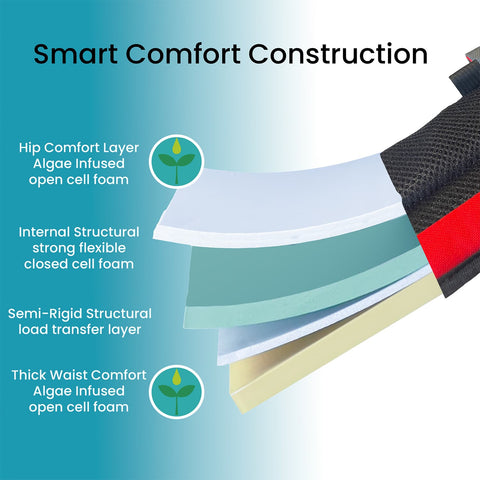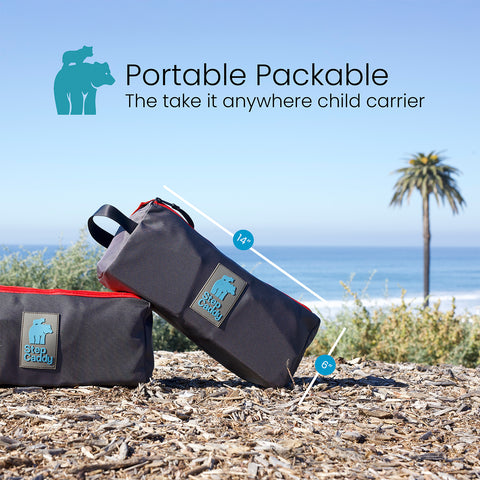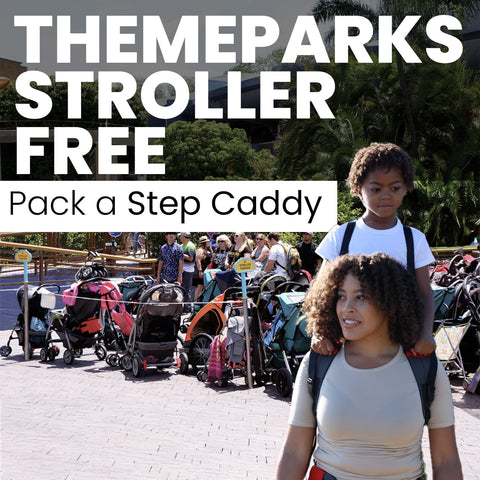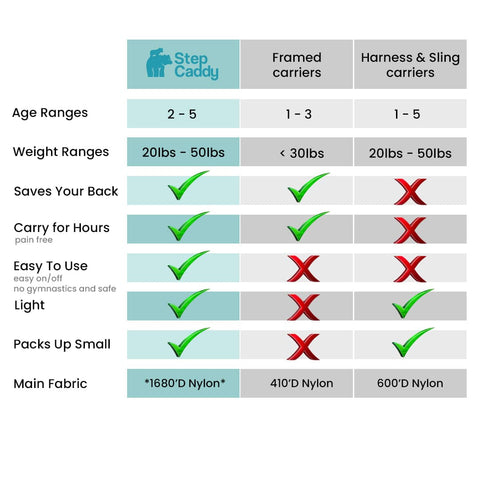If you've got a kiddo who is always on the move, you know how tricky it can be for them to keep up. You start off a walk or hike with good intentions, but soon your toddler's tired legs, or their desire for a better view, mean you're giving piggybacks, juggling bags, and wishing for an extra set of hands. Let's face it, bigger kids still have little legs, tire much faster than adults, are much heavier than they used to be, but still need a lift. Sound familiar? You're not alone. The search for the perfect way to carry an active, bigger kid gets real, fast. That's why more and more parents are comparing traditional soft-structured carriers, strollers, and standing piggyback carriers like Step Caddy for school-aged kids who want their own adventure, but still need a little lift sometimes.
Let's break down the differences, share some honest parent experiences, and help you decide what will keep your family comfortable, safe, and stylish while getting out and about.
What Is a Piggyback Carrier for Older Children?
A piggyback carrier is designed with one major goal: to make carrying your big toddler or preschooler as easy and comfortable as possible, especially when they're too big for a stroller but not quite ready to walk the whole distance by themselves. The most innovative style for older kiddos is the standing piggyback carrier. This includes a platform or stirrups for your child to stand on behind you, just like a classic piggyback (but way safer and easier on your back). Instead of slumping or hanging in a pouch, your child is upright, with their weight distributed on your hips, not your shoulders.
Many parents compare this to the experience of a "piggyback ride," but with the added bonus of security features, such as padded waistbelts, magnetic buckles, and quick on-off options. Unlike traditional soft-structured carriers that cradle your child, piggyback carriers fit kids from about two to five years old, making them a favorite among families who have "aging-out-of-the-carrier" blues.
Real Parent Stories: From Traditional Carriers to Standing Piggyback
When I first tried a soft-structured carrier for my toddler, it seemed like the perfect solution. It was cozy and snug, perfect for napping on the go and navigating the grocery store without squirming. But as my son grew (and got heavier and wiggly!), we both got uncomfortable. My back started to ache by the end of even a short walk, and he was constantly twisting around for a better look.
Switching to a standing piggyback carrier was honestly a game-changer. Suddenly, he loved the higher view, could hop on and off without fuss, and was engaged with exploring because he wasn't trapped. I could carry him for longer periods with less back pain, and my arms were free to hold hands, take photos, or manage snacks. I'm not the only one, one Step Caddy user wrote in:
"Absolutely Amazing Child Carrier. I was absolutely blown away with how light my kid felt when I was carrying him - you feel almost nothing on your shoulders or back. It was great for our hike, and is now essential gear for us. He loved being so high up and also getting on and off constantly."
Pros and Cons: Standing Piggyback Carriers vs. Traditional Carriers & Strollers
No carrier is one-size-fits-all, and each has its strengths and quirks. Here's a quick look at the perks and drawbacks from parents who've tried it all:
Standing Piggyback Carriers
Pros:
- Supports natural standing, fun for adventurous kids
- Weight sits on your hips, so no shoulder or back strain
- Kids get unbeatable views and can chat, point things out, and hop off to walk
- Lightweight and packs small for travel
- Hands-free, so you can manage bags or hold younger siblings
Cons:
- Not designed for babies under two years old
- Less cozy for naps since kids are upright
- Some learning curve for kids getting used to standing and holding on
Traditional Soft-Structured Carriers
Pros:
- Snuggly and secure for smaller children, especially for naps
- Excellent support for infants and young toddlers
- Wide range of styles on the market
Cons:
- Tough on your back and shoulders as your child gets bigger
- Awkward for quick on-off at this age
- Some "big kids" resist being cradled or carried in a "baby" style
Strollers
Pros:
- Great for tired legs, naptime on the go, and carrying lots of stuff
- Sun/rain protection for your child
Cons:
- Bulky and hard to maneuver off-road or in crowds
- Can't always keep an active child contained once they want to hop out
- Not hands-free or easy to use on hiking trails
Can You Carry a 3-Year-Old or 4-Year-Old in a Carrier?
Absolutely. This is a common question, and many parents are surprised to learn that standing piggyback carriers are built exactly for this age group. Products like the Step Caddy can safely carry children from about 2 to 5 years old, with plenty of head and leg room for your growing kiddo. The key is to look for an ergonomic carrier that shifts weight to your hips, not your upper body, so you can go for miles without aches. If your child is between 30-50 pounds and still craves the comfort (and fun!) of getting a lift, you're right in the sweet spot.
Which Toddler Carrier Is Best for Your Family's Style?
There's a lot to consider: are you hiking steep trails, traveling to busy festivals, or just handling school pick-up? If your child loves to engage with the world and needs a quick rest after bursts of activity, a standing carrier like Step Caddy is hard to beat.
For younger toddlers who nap on the go or still like the feeling of being hugged close, you might lean toward soft-structured carriers for now. If you're ditching the stroller completely, piggyback carriers cover the gap between "too big for the baby carrier" and "ready to walk everywhere."
Many parents call Step Caddy the "best preschool carrier" they've tried because it's light, folds flat, and lets adventurous kids feel like part of the action.
Practical Tips for Choosing the Right Carrier
- Check the Fit: Make sure the carrier you choose is designed for both your size and your child's weight/age range.
- Weight Distribution Matters: Look for models that keep weight on your waist or hips instead of your shoulders.
- Safety Features: Opt for sturdy buckles, harnesses, and standing platforms that make getting on and off safe and simple.
- Think About Your Adventures: Choose gear that matches your favorite outings, whether it's rough terrain or urban exploring.
And remember, it's normal to try a few options before finding what makes life easier for both you and your child.
The Bottom Line: Fun, Freedom, and Less Back Ache
Whether you're heading up a mountain, navigating city sidewalks, or just needing a hands-free way to get through your weekend errands, how you carry your growing child can make all the difference. While there's still a place for cozy baby wraps and trusty strollers, the standing piggyback carrier opens up new freedom for you and endless fun for your little one.
If you're tired of the toddler-drag or "just carry me!" pleas (without turning every outing into a workout), this could be the comfort boost your active family needs. I've seen firsthand how the right carrier can transform your adventures from stressful to joyful. Ready to try a smarter, lighter, more engaged way to explore? The Step Caddy might just surprise you and your busy kid.
For more tips about finding the best carrier for hiking or everyday life, check out what makes an ergonomic carrier so game-changing for active families. Happy exploring!

